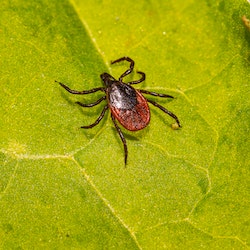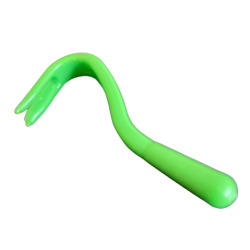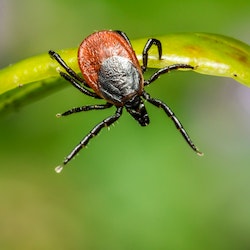Ticks are small parasites that feed on the blood of animals, including dogs and people. They have 8 legs and look a bit like spiders. Over 30% of all dogs will have ticks on them in the summer months. Dogs of any age or breed can get tick bites. Ticks can spread infectious diseases including Lyme disease.

Ticks are the size of tiny seeds when they first latch on to your dog. They stay attached to grow and feed for up to 5 days. Any dog who visits green spaces can get ticks. Ticks can transfer disease by passing infections between animals when they feed on their blood. Lyme disease is the most serious disease spread by ticks in the UK. However, Lyme disease is still very rare in dogs. Irritation or infection at the site of a tick bite is a much more common problem.
What to do
What to do if your dog has a tick
You’re most likely to find a tick on your dog in Spring and Autumn, when ticks are most active. But warmer wetter weather with climate change means ticks are a year-round problem. Once a tick attaches, it takes 1-3 days for bacteria to be transferred from the tick to the animal they are feeding on.
- Check your pet at the end of each day.
- Remove ticks as soon as you find them.
- It’s important to remove ticks without leaving the mouthparts inside your pet’s skin.
- Use a special tick-removing tool.

- Check the whole tick is removed, including the mouthparts
- Dispose of ticks safely, ideally wearing gloves- wrap tightly in tape, flush down the toilet or put in a sealed bag.
- Bathe the site of the tick bite with warm salt water (1 teaspoon of salt to one pint of warm water) or an antiseptic solution such as chlorhexidine (Hibiscrub).
- Continue to bathe for 3-5 days.
If mouthparts are still in your dog:
- Try to remove the mouthparts with tweezers if you can see them.
- Continue to bathe the bite with salt water or antiseptic.
- Check for signs of infection, including redness, swelling, pain or licking.
- Tick mouthparts will usually come out eventually.
There are treatments available to repel and/or kill ticks on dogs, However, no treatment is 100%. So it’s essential to check your pet every day for ticks.
Causes
How dogs get ticks
Ticks can’t fly, jump or spin webs. They get onto dogs by climbing up blades of grass so they can latch on to them as they brush past.

Dogs are most likely to pick up ticks if they are:
- Walking in woodland, moorland, fields and anywhere that green space is shared with wildlife, such as deer, sheep or hedgehogs.
- Spending time in your garden.
- Living in a ‘higher-risk’ area, including the South West of England, East Anglia, the Scottish Highlands and Islands and Northern England.
You can find out the risk of ticks in your area by looking up an interactive map created from the Big Tick Survey
Ticks that are not native to the UK are surviving more easily in our changing climate. Pet travel and imported dogs increase the risk of these parasites and diseases they carry entering the UK.
When to worry
When to worry about your dog having ticks
Ticks don’t usually cause disease themselves, but they may carry bacteria and other microbes that do cause dangerous illnesses. Lyme disease is the most serious and common disease transmitted through tick bites in the UK.
- Around 2.5-5 % of ticks in the UK carry Lyme Disease
- 95% of dogs bitten by infected ticks will not develop any symptoms.
- Of the remaining 5%, most dogs only develop mild symptoms
A very small number of dogs bitten by infected ticks may develop symptoms of more severe illness, including:
- Fever
- Loss of appetite
- Lethargy (tiredness)
- Lameness and painful joints in one or more limbs
- Enlarged lymph glands
- Life-threatening kidney disease (although this is very rare)
Other rare diseases which can be spread by ticks include babesiosis, tick-borne fever and ehrlichiosis.
What ticks look like
Ticks often look like small lumps or skin tags and it can be hard to tell the difference
- Call a vet if you have find any unexplained lump which grows rapidly
Joii can help with
- Advice on tick preventive treatments
- How to remove a tick safely
- What to do if the bite looks red or irritated
- Recognising signs and risks of Lyme Disease
Prevention
Tips on how to prevent your dog from getting ticks
Treatments to repel and/or to kill ticks on pets are readily available. However, no treatment is 100%. So it’s essential to check your pet every day for ticks.
Ticks will still bite your dog even if you’ve used a preventive treatment. The tick will die within 12-24 hours, which is too soon for it to spread disease to your dog.
- Tick preventive treatments include spot-on treatments, sprays and tablets
- Treatments last between four and twelve weeks.
- There is also a special collar for dogs called “Seresto”, which lasts for 8 months and is ideal for dogs who travel abroad.
- The ‘best’ option depends on your dog or cat’s lifestyle and how easy it is to give them pills.
- Dogs who swim will be better with tablets. Swimming interferes with surface spot-on treatments and the chemicals they contain can damage water courses.
- Some dogs just won’t take tablets!
Never give dog medication to cats and vice versa. This can be extremely dangerous for your pet.
There is one Lyme disease vaccine available in the UK for dogs at high risk
A vet can advise you on the best product for your pet.
Diagnosis
Things to look out for
Tick bites aren’t painful unless they get infected, so your dog is unlikely to alert you. Check them over at the end of each day.
- To begin with, ticks look like tiny dark skin tags or moles
- Look carefully for a gap between the base of the lump and the body
- You may see the legs of the tick and part of the mouth-parts entering your dog <insert image>
- After feeding on blood, ticks grow to resemble a smooth grey, bluish or brown coffee bean
Common locations for ticks on pets:
- Armpits
- Groin
- Head
- Neck
- Paws and legs
Home treatment
Home remedies for ticks in dogs
It’s best to remove ticks as soon as you find them. If you don’t have a tick remover, use blunt-ended tweezers. You can remove larger ticks with your fingers.
- Carefully grasp the tick at the base of the body, next to your dog’s skin.
- Draw back gently.
- Check the whole tick has been removed
What not to do if your dog has ticks
The following methods should never be used to remove ticks:
- Crushing
- Covering with petroleum jelly (Vaseline)
- Burning
- Dousing with white spirit
These actions make the tick eject its stomach contents into your pet before they die and increase the risk of infections.
Vet treatment
Vet treatments for ticks
- Vets can prescribe the strongest forms of products to prevent ticks and other parasites
- Antibacterial and anti-inflammatory creams and ointments can settle skin irritation from tick bites
- Lyme disease is treated with antibiotics
- The sooner dogs with symptoms of Lyme Disease are treated, the better their chances of complete recovery.
Risk
Dogs at higher risk of getting ticks
The following factors increase your dog’s risk of getting a tick:
- Exercising where livestock graze or deer are common
- Having shorter legs so closer to grass and vegetation
- Having long hair, which also makes ticks harder to find
- Being a working dog
- Living in parts of the country where ticks are most common
Is my family at risk if my dog has ticks?
- Humans and other pets won’t catch Lyme Disease from an infected dog.
- Humans and other pets are also at risk of tick bites if they go to the same places for walks.
- Pets can bring ticks into the house but ticks rarely spread between dogs or humans








